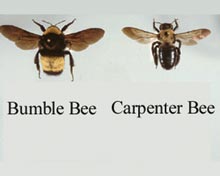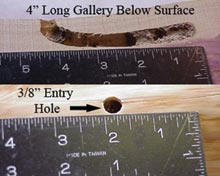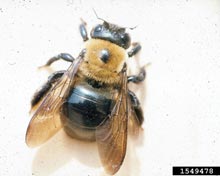
R.J. Bauernfeind, Kansas State University: www.ksre.ksu.edu/hfrr.extensn/POW/2003/June_4.htm

R.J. Bauernfeind, Kansas State University: www.ksre.ksu.edu/hfrr.extensn/POW/2003/June_4.htm

Jim Baker, North Carolina State University
Carpenter Bee
General Description
The eastern carpenter bee (Xylocopa virginica) is a bumble bee look-alike that has a shiny, all black abdomen,
whereas the bumble Bee’s abdomen is fuzzy, black and yellow. Eastern carpenter bees are between one-half of
an inch to three-fourths of an inch long and solitary. Females chew one-half inch diameter holes and bore tunnels
that run several inches into the wood. Eggs are laid inside and the resulting larvae develop on a mixture of
pollen and nectar. Males guard the nest by buzzing intruders, but their defense is a bluff; male bees cannot sting.
Female carpenter bees can sting but rarely do.
General Control
Damage from numerous carpenter bees drilling into wooden surfaces such as window sills, wooden siding,
eaves, deck railings, outdoor furniture and fences can be significant. Carpenter bees will attack painted or stained
wood surfaces though bare wood is preferred. The burrows of carpenter bees can be treated with appropriatelylabeled
insecticide dust, aerosols or residual liquids under pressure. All entry holes should be filled, e.g. with
wood putty.









